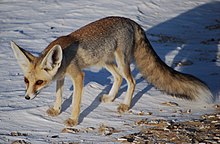User:Jjt010/Wildlife of Iraq
| This is the sandbox page where you will draft your initial Wikipedia contribution.
If you're starting a new article, you can develop it here until it's ready to go live. If you're working on improvements to an existing article, copy only one section at a time of the article to this sandbox to work on, and be sure to use an edit summary linking to the article you copied from. Do not copy over the entire article. You can find additional instructions here. Remember to save your work regularly using the "Publish page" button. (It just means 'save'; it will still be in the sandbox.) You can add bold formatting to your additions to differentiate them from existing content. |
Article Draft[edit]
Lead[edit]
Article body[edit]
Due to its diversity in biomes from the Mesopotamian marches along the Euphrates River to the semi-arid deserts, Iraq is home to a wide variety of endemic animals and animals that are well-known worldwide for their prevalent populations.
Mammals



The Eurasian otter and the smooth-coated otter [1] are carnivorous semiaquatic mammals located in the marshes and rivers whose diets consist of primarily fish, amphibians, crustaceans, insects and birds, but their populations have seen a decline since the 1970s.[2] The Persian leopard is a large carnivorous feline located in the northern forest whose diet consists of primarily wild goats. A small population was recorded for the first time at the beginning of the 21st century in the border region between Iraq and Turkey.[3] The sand cat whose presence was recorded for the first time in the desert of Al-Najaf[4] is a small carnivorous feline located in the sandy deserts (diet consists of small rodents, cape hare, greater hoopoe lark, desert monitor, sandfish, cerastes vipers). The Wildcat is a small feline located primarily in forest whose diet consist of rodents, birds, small reptiles[5] and poultry.[6] The Rüppell's fox is a small omnivorous canine that located in deserts north of the Euphrates river whose diet consists of insects, small mammals, lizards, and birds.[7] The Marbled polecat is a omnivorous weasel located in deserts of N.Iraq whose diet consists of small rodents, birds, lizards, fish, frogs, fruit, and grass.[8] The Small Indian mongoose [9] small omnivorous weasel located in the alluvial plains whose diet consists of insects(dragonflies, grasshoppers, mole crickets, ground beetles, earwigs), rodents, amphibians, reptiles, small birds, small grasses, small fruits.[10][11] The Goitered gazelle is a herbivorous antelope that is located in mountains and areas of broken terrain. The Wild boar is a omnivorous swine located in the marshes and along the numerous rivers in Iraq whose diet consists of plants(rhizomes, roots, bulbs, tubers, nuts, berries, seeds, leaves, bark, twigs, shoots), earthworms, insectivores, insects, rodents, bird eggs, lizards, snakes, frogs, and carrion.[6] The Bactrian camel is located in varying habitats from rocky mountains to arid deserts and has a herbivorous diet that consists of various kinds of vegetation.[12] The European hare is a herbivorous rodent located in the plateaus of Iraq and along the Tigris river.
Other mammals include:
- Indian crested porcupine
- Caucasian squirrel
- Broad-toothed field mouse
- Yellow-necked mouse
- House mouse
- Black rat
- Short-tailed bandicoot rat
- Indian gerbil
- Sundevall's jird
References[edit]
- ^ Mirzaei, R.; Conroy, J.; Yoxon, P. (2010). "Otters in the Hawr al Azim wetland, Iran". Italian Journal of Mammalogy. 21 (1): 83–88. doi:10.4404/hystrix-21.1-4457.
- ^ Mirzaei, Roohallah; Conroy, Jim; Yoxon, Paul (2010-08-27). "Otters in the Hawr al Azim wetland, Iran". Hystrix, the Italian Journal of Mammalogy. 21 (1). doi:10.4404/hystrix-21.1-4457. ISSN 0394-1914.
- ^ Avgan, Batur; Raza, Hana; Barzani, Muhammadsaddik; Breitenmoser, Urs (2016-04-02). "Do recent leopard Panthera pardus records from northern Iraq and south-eastern Turkey reveal an unknown population nucleus in the region?". Zoology in the Middle East. 62 (2): 95–104. doi:10.1080/09397140.2016.1173904. ISSN 0939-7140.
- ^ Mohammad, M. K.; Lahony, S. R.; Al-Rammahi, H. M. (2013). "First record of the Sand Cat, Felis margarita Loche, 1858 (Mammalia: Carnivora, Felidae), from Iraq". Zoology in the Middle East. 59 (4): 358–359. doi:10.1080/09397140.2013.868144. S2CID 85019590.
- ^ Herbst, M.; Mills, M. G. L. (2010-04). "The feeding habits of the Southern African wildcat, a facultative trophic specialist, in the southern Kalahari (Kgalagadi Transfrontier Park, South Africa/Botswana)". Journal of Zoology. 280 (4): 403–413. doi:10.1111/j.1469-7998.2009.00679.x. ISSN 0952-8369.
{{cite journal}}: Check date values in:|date=(help) - ^ a b Geptner, V. G. (Vladimir Georgievich); Nasimovich, A. A.; Bannikov, Andrei Grigorevich; Hoffmann, Robert S. (1988). Mammals of the Soviet Union. Smithsonian Libraries. Washington, D.C. : Smithsonian Institution Libraries and National Science Foundation.
- ^ Lindsay, I. M.; Macdonald, D. W. (1986-01-01). "Behaviour and ecology of the Ruppell's fox, Vulpes ruppelli, in Oman". 50 (4): 461–474. doi:10.1515/mamm.1986.50.4.461. ISSN 1864-1547.
{{cite journal}}: Cite journal requires|journal=(help) - ^ Roberts, T. J. (2005). Field guide to the large and medium-sized mammals of Pakistan. Karachi: Oxford University Press. ISBN 0-19-579568-7. OCLC 70619354.
- ^ Harrison, David L. (1968-09). "The Large Mammals in Arabia". Oryx. 9 (5): 357–363. doi:10.1017/S0030605300006992. ISSN 1365-3008.
{{cite journal}}: Check date values in:|date=(help) - ^ Mahmood, Tariq; Adil, Ayesha (2017-01-01). "Diet composition of small Indian mongoose (Herpestes javanicus) varies seasonally in its native range". Animal Biology. 67 (1): 69–80. doi:10.1163/15707563-00002516. ISSN 1570-7563.
- ^ Akrim, Faraz; Mahmood, Tariq; Nadeem, Muhammad Sajid; Qasim, Siddiqa; Andleeb, Shaista; Fatima, Hira (2019-05). "Distribution, Dietary Breadth and Niche Overlap between Two Sympatric Mongoose Species Inhabiting Pir Lasura National Park, Azad Jammu and Kashmir, Pakistan". Pakistan Journal of Zoology. 51 (4). doi:10.17582/journal.pjz/2019.51.4.1497.1507. ISSN 0030-9923.
{{cite journal}}: Check date values in:|date=(help) - ^ Schmidt, Amanda. "Camel Fact Sheet | Blog | Nature | PBS". Nature. Retrieved 2023-04-27.
